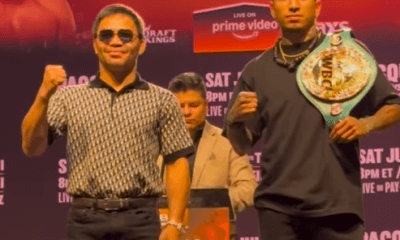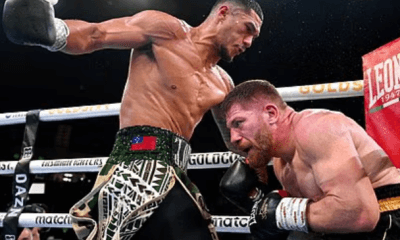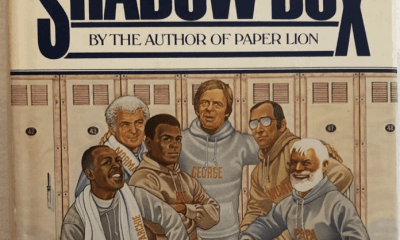Featured Articles
Maybe Pacquiao Should Fight Bradley Again If He Beats Rios
It’s amazing how in professional sports things are week to week, or game to game. The same thing holds true in boxing, being that perceptions and opinions are fight to fight.
Two weeks ago it seemed as if it would be senseless for Manny Pacquiao 54-5-2 (38) to fight a rematch with WBO welterweight title holder Timothy Bradley 31-0 (12). However, if Pacquiao beats Brandon Rios 31-1-1 (23; the two are pictured in Will Hart-HBO photo from their NYC presser this summer) next month, a rematch with Bradley just may be the best option for Manny if he can’t finagle a way to coax Floyd Mayweather 45-0 (26) into fighting him.
Getting by Rios is in no way a given for Pacquiao. Brandon is as tough as they come and if Pacquiao has eroded physically, it will be very pronounced against Rios’ aggressive and rough style. However, if Pacquiao is the fighter he was versus Juan Manuel Marquez 56-7-1 (40) in his last fight before he got caught with the best punch Marquez has ever landed and was stopped, he should get by Rios because he is clearly a tier better fighter. So where does Pacquiao turn if he beats Rios?
Some would say he still has a score to settle with Marquez, but what is in it for him to gain? Their first three fights were extremely close and there’s a case to be made for either one as to who won. When they met for the fourth time, Manny was working Marquez over, had his face busted up and bleeding and looked as if he was a round or two away from halting Marquez for the first time. Then Marquez caught him with a counter right hand at the end of the sixth round that was heard around the boxing world and knocked him out. If they fought again it would most likely go the distance and the decision would be disputed. And with Marquez being clearly out-boxed by Bradley earlier this month, Pacquiao has nothing to gain by defeating his 40 year old career rival at this stage of the game.
Enter Timothy Bradley.
In Bradley’s last three fights he’s won a disputed decision over Pacquiao, showed all the heart in the world and survived a war in out-pointing Ruslan Provodnikov, who may be one of the best attackers in professional boxing. And in his last bout, he out-boxed Marquez more thoroughly and completely than Pacquiao ever did over the course of the 42 rounds he and Marquez have fought. That’s pretty impressive on Bradley’s part and more noteworthy than what Pacquiao or Marquez have accomplished over their last three fights. Bradley always shows up in great condition, has fast hands, an improving boxing aptitude, takes a good punch and possess a willing heart and will do whatever he needs to in order to win. On top of that Bradley has officially defeated Pacquiao.
In regards to their fight back in June of last year, Bradley was the benefactor of a split decision verdict, with two judges scoring it 115-113 in his favor and the third judge seeing it the opposite, 115-113 Pacquiao. A score of 115-113 on points works out to be 7-5 in rounds. So basically the fight was one round away from being scored a draw on all three judges scorecards, which indicates how close and tough the fight was to score.
I have maintained as long as I’ve followed or been involved with the sport of boxing that the only score that counts when scoring a fight is the score you tabulated the night of the fight when you watched it live and in the moment before you knew the result. Going back and re-watching fights is something we all do. The problem with that is we know the result and also know that fighter B survived that big left-hook in the fourth round when the crowd was yelling and he looked like he was really shook and in trouble. Watching the replay you see that fighter A didn’t do as much scoring as you thought as he did while watching the fight in the moment. I can think of several fights that I saw in person or on TV that when I went back and re-watched them, turns out the bout was closer than I remembered it being. Hagler-Leonard is a perfect example. Watching it live I thought Leonard took Hagler to school and gave him a boxing lesson. Watching it again a few months back it was closer than I remembered it to be the night I watched it live without knowing which way it was gonna go. Too bad. The only score that matters is the one I concluded the night of the fight. Like the judges, we only get one chance to score any fight live, and that’s all that counts. The night I watched Hagler-Leonard in the moment I thought it was a clean win for Leonard. So Leonard must have done enough while the fight was unfolding to sway me because I know what I’m watching and how to score a fight.
The night I watched Pacquiao-Bradley live, I was adamant that Manny won the fight by two or three points. I thought Bradley appeared to be shook a few times and looked as if he was fighting to survive more than to win. And in the time that has passed since many other fight observers saw it the same way. Almost every time the Pacquiao-Bradley clash is mentioned, it’s followed by words such as “controversial or disputed decision in Bradley’s favor.” Having said that, I believe Pacquiao-Bradley is another example as to why you can only count the score you came up with while watching it live because on tape it looks a little different. I received more than a few e-mails from people whose boxing opinion I respect who have gone back and watched Pacquiao-Bradley again and see it a little differently. So I did that and you know what, despite it meaning nothing as to what I saw when I watched it live, I see it closer and closer every time I’ve watched the tape. No, I don’t think Bradley won, but I’m more open to hearing the case that he did than I was before. And even though my mind hasn’t changed as to who won, I’m not sure that Pacquiao beat Bradley beyond all doubt and would like to see them lock up one more time. Bradley has improved and is more confident and fought better down the stretch of the bout against Pacquiao and Manny just may have something to prove that he clearly did beat Bradley the first time.
I really don’t want to see Mayweather-Pacquiao because it’s four years over due, but I know a majority of the boxing world wants to see it. I’ve maintained that Floyd would’ve beat Manny fours years ago and would handle him more easily now. Regardless, Mayweather-Pacquiao is the biggest fight in combat sports, so if Pacquiao beats Rios he should go after Mayweather.
But if he can’t get Mayweather, Bradley wants him again and Pacquiao should look at him as his next best option if he wants to continue fighting. At this point, Bradley is still technically undefeated, he’s got wins over both Pacquiao and Marquez, holds a title, beat a hot property in Provodnikov, and there’s nobody else whose credentials are as solid.
Frank Lotierzo can be contacted at GlovedFist@Gmail.com
-

 Featured Articles3 weeks ago
Featured Articles3 weeks agoAvila Perspective, Chap. 330: Matchroom in New York plus the Latest on Canelo-Crawford
-

 Featured Articles2 weeks ago
Featured Articles2 weeks agoVito Mielnicki Jr Whitewashes Kamil Gardzielik Before the Home Folks in Newark
-

 Featured Articles4 weeks ago
Featured Articles4 weeks agoAvila Perspective, Chap 329: Pacquiao is Back, Fabio in England and More
-

 Featured Articles4 weeks ago
Featured Articles4 weeks agoOpetaia and Nakatani Crush Overmatched Foes, Capping Off a Wild Boxing Weekend
-

 Featured Articles3 weeks ago
Featured Articles3 weeks agoCatching Up with Clay Moyle Who Talks About His Massive Collection of Boxing Books
-

 Featured Articles4 weeks ago
Featured Articles4 weeks agoFabio Wardley Comes from Behind to KO Justis Huni
-

 Featured Articles2 weeks ago
Featured Articles2 weeks agoMore Medals for Hawaii’s Patricio Family at the USA Boxing Summer Festival
-

 Featured Articles4 weeks ago
Featured Articles4 weeks agoDelving into ‘Hoopla’ with Notes on Books by George Plimpton and Joyce Carol Oates
















